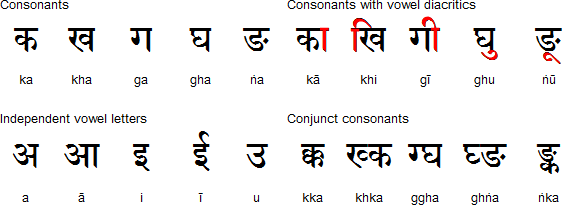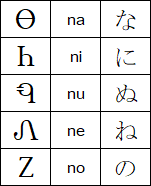Writing systems can be divided into two main types: those that represent consonants and vowels (alphabets), and those which represent syllables (syllabaries), though some do both. There are a number of subdivisions of each type, and there are different classifications of writing systems in different sources.
Writing systems: Abjads | Alphabets | Abugidas | Syllabaries | Semanto-phonetic scripts | Undeciphered scripts | Alternative scripts | Constructed scripts | Fictional scripts | Magical scripts | Index (A-Z) | Index (by direction) | Index (by language) | Index (by continent) | What is writing? | Types of writing system | Differences between writing and speech | Language and Writing Statistics | Languages
Abjads, or consonant alphabets, have independent letters for consonants and may indicate vowels using some of the consonant letters and/or with diacritics. In Abjads such as Arabic and Hebrew full vowel indication (vocalisation) is only used in specific contexts, such as in religious books and children's books.
The image below shows the word 'language' in Arabic and Hebrew, both without vowel marks (unvocalised) and with vowel marks (vocalised).

In Semitic languages like these most words have roots made up of three consonants, e.g. k-t-b (كتب) is the root for words related to marking, inscribing or writing in Arabic. Adding vowels and other consonants to such roots creates different words such as كاتب (katib - writer), كتاب (kitab - book), مكتب (maktab - office) and مكتبة (maktaba - library).
Many of the ancient alphabets used in West Asia and North Africa were abjads, as are the Arabic and Hebrew scripts.
[top]
Alphabets, or phonemic alphabets, are sets of letters that represent consonants and vowels. In some languages, such as Czech, each letter or combination of letters represents one sound, while in others, such as English, letters might represent a variety of sounds, or the same sounds can be written in different ways.

Here is an example of how the sh sound [ʃ] is represented in different languages and alphabets:
The most widely-used alphabets are the Latin or Roman alphabet and the Cyrillic alphabet. They have been adapted to write hundreds of different languages and are used on every continent.
More information about alphabets
[top]
Syllabic alphabets, alphasyllabaries or abugidas are writing systems in which the main element is the syllable. Syllables are built up of consonants, each of which has an inherent vowel, e.g. ka, kha, ga, gha. Diacritic symbols are used to change or mute the inherent vowel, and separate vowel letters may be used when vowels occur at the beginning of a syllable or on their own.
The illustration below shows some of the letters and other symbols used in Devanagari, which is used to write Hindi, Marathi, Nepali and many other languages. The vowel diacritics are highlighted in red, and the consonant clusters are used when two or more consonants occur together without vowels between them.

Most of the writing systems used in South and South East Asia are syllabic alphabets
More information about syllabic alphabets
[top]

A syllabary is a phonetic writing system consisting of symbols representing syllables. A syllable is often made up of a consonant plus a vowel or a single vowel.
The illustration shows a selection of symbols from Japanese Hiragana and Cherokee. In Cherokee there is a separate symbol for each sound. In Hiragana most sounds have a their own symbol, but some sounds are written by adding extra marks to a symbol. For example ひ = hi, び = bi and ぴ = pi.
More information about syllabaries
[top]
The symbols used in semanto-phonetic writing systems often represent both sound and meaning. As a result, such scripts generally include a large number of symbols: anything from several hundred to tens of thousands. In fact there is no theoretical upper limit to the number of symbols in some scripts, such as Chinese. These scripts could also be called logophonetic, morphophonemic, logographic or logosyllabic.
Semanto-phonetic writing systems may include the following types of symbol:
Pictograms or pictographs resemble the things they represent. Logograms are symbols that represent parts of words or whole words. The image below shows some examples of pictograms from the Ancient Egyptian Hieroglyphic and Chinese scripts. The Chinese characters used to look like the things they stand for, but have become increasingly stylized over the years.

Ideograms or ideographs are symbols which graphically represent abstract ideas. The image below shows a number of ideographic Chinese characters.

The majority of characters in the Chinese script are semanto-phonetic compounds: they include a semantic element, which represents or hints at their meaning, and a phonetic element, which shows or hints at their pronunciation. Below are a some compound characters which all share the element meaning 'horse' (馬 [马] mǎ), which is used both as a semantic component and as a phonetic component.
Source: https://www.mdbg.net/chinese/dictionary?page=chardict&cdqchc=%E9%A6%AC
Sometimes symbols are used for their phonetic value alone, without regard for their meaning, for example when transliterating foreign names and loan words.
More information about semanto-phonetic writing systems
[top]
Writing systems that have yet to be deciphered or have only been partially deciphered.
More information about undeciphered writing systems
[top]
[top]
Constructed scripts for: Ainu | Arabic | Chinese languages | Dutch | English | Hawaiian | Hungarian | Japanese | Korean | Lingala | Malay & Indonesian | Persian | Tagalog / Filipino | Russian | Sanskrit | Spanish | Taino | Turkish | Vietnamese | Welsh | Other natural languages | Colour-based scripts | Tactile scripts | Phonetic/universal scripts | Constructed scripts for constructed languages | Adaptations of existing alphabets | Fictional alphabets | Magical alphabets | A-Z index | How to submit a constructed script
[top]
Writing systems: Abjads | Alphabets | Abugidas | Syllabaries | Semanto-phonetic scripts | Undeciphered scripts | Alternative scripts | Constructed scripts | Fictional scripts | Magical scripts | Index (A-Z) | Index (by direction) | Index (by language) | Index (by continent) | What is writing? | Types of writing system | Differences between writing and speech | Language and Writing Statistics | Languages
Page last modified: 22.09.21
[top]
You can support this site by Buying Me A Coffee, and if you like what you see on this page, you can use the buttons below to share it with people you know.

If you like this site and find it useful, you can support it by making a donation via PayPal or Patreon, or by contributing in other ways. Omniglot is how I make my living.
Note: all links on this site to Amazon.com, Amazon.co.uk
and Amazon.fr
are affiliate links. This means I earn a commission if you click on any of them and buy something. So by clicking on these links you can help to support this site.
[top]